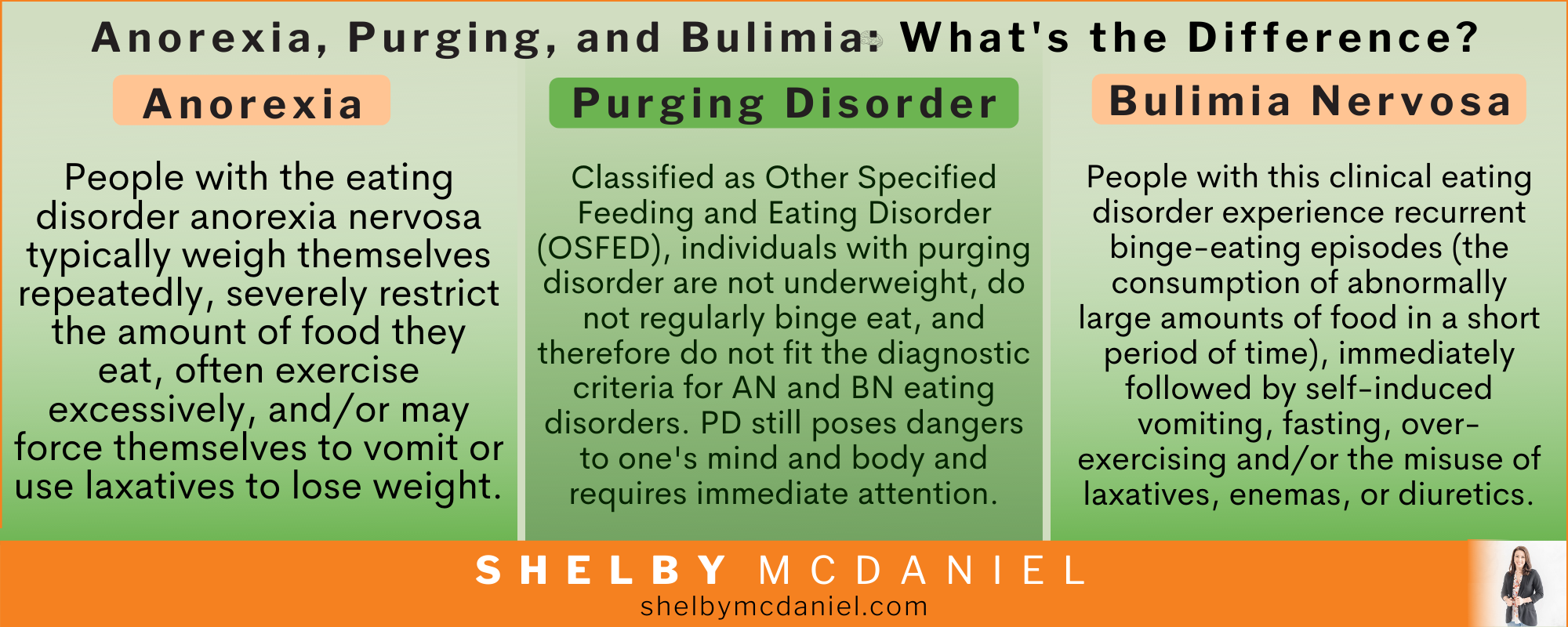While much attention has been paid to clinical eating disorders such as anorexia nervosa and bulimia, some other disorders such as purging disorder are less well known and not often discussed.
There’s actually a whole other range of disordered eating patterns that affect an even broader portion of the population. And the reason why we don’t hear those such as purging disorder is that, well, they’re not so clear-cut.
Disordered eating can result from various factors, which, while hugely impact-full, will rarely put someone into required clinical care or hospitalization because they are not life-threatening, but they are always life-changing.
When so much of our energy and focus is placed on what we just ate, how much we weigh, and what we’ll eat next, we rob ourselves from living our lives in a joyful way. Struggles with disordered eating is an everyday, painful reality for many, many people, despite the amazing advancements we have made in our understanding of nutrition, fitness, and wellness.
Let’s take a moment now to clear the air about disordered eating patterns of purging.
What Exactly Is Purging Disorder?
According to the scientific community, Purging Disorder (PD) is characterized by recurrent purging after normal or small amounts of food. Purging disorder sort of occupies a space that falls between anorexia and bulimia nervosa eating disorders, making it ‘not quite’ anorexia and ‘not quite’ bulimia.

Estimates vary, but up to 5% of women experience purging disorder in their lifetime and less than .5% of boys and young adult men. Now, what makes this disorder different from bulimia nervosa is that with bulimia, people eat large amounts of food before purging. This absence of always binge eating prior to purging separates purging disorder from bulimia nervosa.
Purging behaviors are oftentimes associated with self-control rather than excessive amounts of food and are common among individuals with body image disturbance but who are not underweight. Those who struggle with purging also typically have an intense fear of gaining weight and a strong desire to lose weight, which is often noted by low self-esteem.
Many people start the behavior as a weight management strategy for personal purposes, believing they can get rid of calories they feel guilty for eating. Research shows that even if you vomit immediately after binge eating, your body absorbs at least 30-40% of the calories in the food that you eat minimum.
Outside of weight management, purging can also be used to regulate mood, avoid the sensation of fullness, or self-harm or punish oneself. One may engage in self-induced vomiting simply out of (unhealthy) habit.
Signs of Purging Disorder
- Rushing to the bathroom immediately after meals
- Distorted reactions and perceptions of meal portions, feeling as if one’s eating habits are out of control even though they consume small amounts.
- Complaints of frequent diarrhea
- Stained teeth (from vomiting)
- Continual harping on their weight
- Irritability
- Increased anxiety
- Avoiding eating in public situations
- Complain about feeling uncomfortably full, even after a small meal.
- Mood swings
- Weak skin and nails
Ongoing purging behaviors can lead to:
- Metabolic disturbances
- Rips in the esophagus
- Swollen salivary glands
- Dehydration
- Dental Decay
- Electrolyte imbalances
- Gastrointestinal issues
- Inhibited immune system
- Increased anxiety and depression
How to Improve Your Purging
I have helped many clients who have struggled with purging multiple times per week or on and off throughout their entire lives. Like binge eating, purging behaviors are powerful eating concerns that get our attention in a BIG way. In my opinion, today’s scientific community is “medicalizing” both purging and binge eating “disorders.” Meaning it is one more disorder that involves a “chemical reaction,” which requires — yep — medication. When this happens, we are collectively driven to see this as a “brain chemistry issue” – which it is clearly NOT.
Purging can be worked with, listened to, and transformed without the use of pharmaceuticals. It is often a symptom of something hidden deeper that is asking for attention, for healing. It is about unseen, unnoticed energies churning in our depths, asking us to be with and address our deepest concerns, fears, and emotions. Following a perfect macro diet or counting points will not address the root issues behind purging behaviors.
Common ways we help individuals heal their purging
- Restore their relationship with food using fundamental mind-body strategies and dynamic eating psychology.
- Cognitive-behavioral therapy addresses toxic thinking and belief patterns surrounding food and self that are provoking purging and other unwanted eating behaviors. Oftentimes, individuals will have emotional trauma, low self-esteem, anxiety, a history of self-harm, or substance abuse disorders that drive them to engage in self-induced purging.
- Embodiment strategies — the key to developing body wisdom, to feel the pleasures of life, and to live fully. Eating challenges such as purging, weight worry, body image concerns, binge eating, and emotional eating are all acts of disembodiment. The more present (embodied) you are, the more metabolic power you have. It’s absolutely impossible for you to achieve real, lasting weight loss, inner happiness, or any kind of deep level healing if you are checked out of your body.
- Stress management skills are crucial as we are not always taught how to communicate well, express feelings, healthfully self soothe and resolve inner and outer conflicts. Many of us as children are astute enough to notice the pain and intensity of the environment we live in but do not have the tools to address it. Disordered eating, such as purging, can grow out of such conditions, and until one obtains stress management skills, disordered eating behaviors will more than likely continue.
If you’re the one struggling with purging, know that you don’t have to look at food as an enemy. We believe our challenges around food and health are here to ask us to grow. They are actually messengers of insight and wisdom that ask us to take a more in-depth look at our inner and outer worlds.
Think about when an irritant enters an oyster; the oyster creates a beautiful pearl to surround and overcome it. This is the purpose of an eating disorder or disordered eating — to help us reach a higher place of beauty, grace, and growth when life presents us with its inevitable challenges.
You are not alone. There are ways to work through your purge urges. Stay out of secrecy and shame. You deserve help, dignity, and a balanced relationship with food and your body. It’s very possible to have freedom from the compulsion to purge. Please schedule a breakthrough clarity call with our team as your first step to breaking these unhealthy eating cycles. Healing happens most easily with support, guidance, and company.
Enjoy this article? Join the movement to change the conversation around food and diet culture by sharing this post!


